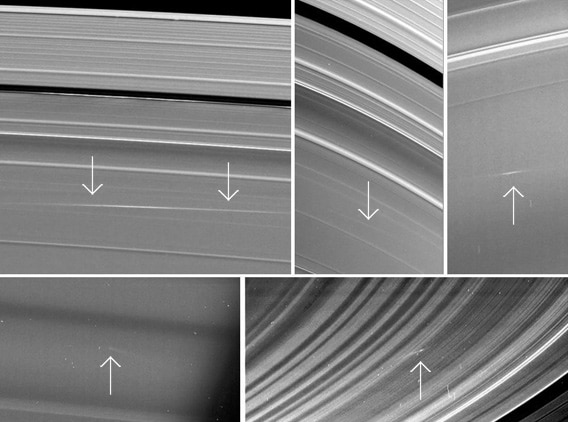Create a free profile to get unlimited access to exclusive videos, sweepstakes, and more!
Cassini Sees Debris from Meteoroids Colliding with Saturn’s Rings

Space is a dangerous place to be; tiny rocks fly around at high speed, and a collision with one can ruin your whole day.
The bigger a target you are, the more at risk you are, of course, and things donât come much bigger than Saturnâs rings. At 300,000+ kilometers across (180,000 miles), they present a juicy target for meteoroidsâheck, from above they even look like a bulls-eye!
The Cassini spacecraft has been orbiting Saturn since 2004, and has had a long, long time to look at the rings. Itâs inevitable it would see these collisions, and now a new study has found nine such collisions from the years 2005, 2009, and 2012.
The image above shows four of the collisions seen by Cassini. The one at the top left was caught about a day after impact, and the picture to the right of it shows the same impact about a day later. The other pictures show different impacts caught mere hours after they occurred.
Saturnâs rings are not solid, but are composed of countless trillions of small icy particles. When a meteoroid (a small solid piece of errant material) plows through them at high speed, it vaporizes and creates an expanding debris cloud. The astronomers doing the study think that this slows the particles down, putting them in orbit around Saturn. Later, these secondary particles collide with the rings at slower speeds, causing the long trails of debris seen here.
Youâd think that would be easy to spot, but in reality these features are pretty difficult to find. The event has to be big enough to see, first of all. The rings are peppered with extremely small impacts all the time, but from hundreds of thousands of kilometers away Cassini doesnât have much chance to see them. Bigger ones are more rare, which is why so few have been seen.
Plus, the lighting conditions have to be right. In the first four images above, the rings were nearly edge-on to the Sun (it was Saturnâs spring equinox), so the trailed clouds of impact debris were easier to spot rising out of the plane of the ultra-thin ringsâto scale, the rings are thinner than a sheet of paper!
The meteoroids that hit the rings range in size from a centimeter to several meters in size. Interestingly, the astronomers who did the new study were able to estimate the rate of collisions judging from the impacts seen, and apparently for objects this size they happen at Saturn at about the same rate they do here at Earth. Saturn is in a relatively emptier region of space than Earth is, but its gravity is also far higher. These two factors must more-or-less cancel, so that impact rates are about the same there as here.
Another interesting fact is that the clouds expand and shear out over time as the particles from the collision orbit Saturn at different rates. This allows astronomers a way to determine how long itâs been since the impact event when looking at a picture.
Features similar to this have been seen before, but those were low speed collisions caused by material in the ring itself clumping up and moving around, disturbed by the gravity of a passing moon. While dramatic and beautiful, those âmini-jetsâ are a far less energetic phenomenon than whatâs seen here.
A side note: This result was only made possible because Cassini was designed to go to Saturn and stay there, exploring that alien environment for years. The longer we look, the more we learn about the weird goings-on around Saturn. Itâs a locale of forbidding beauty and incredible vistas, and it teaches us a lot about the solar system, about planets, and about the way the two interact. This knowledge at the very least teaches us more about the Earth, and is useful⦠but I prefer to think about ding this as learning for the sake of learning. Itâs what humans do, and I think itâs in large part what makes us human. Weâre curious. We explore. We learn.
Right now, NASAâs planetary exploration budget is gasping for life; the Presidentâs proposed budget cuts an incredible $200 million from our study of the solar system and the worlds within it. Congress is, as I write this, debating NASAâs planetary budget. Please write your Congresscritters and let them know that you support planetary exploration with missions like Cassini. If NASA doesnât get the funding it needs, images like these from Cassini will be among the last we see from the outer solar system for a long, long time.














